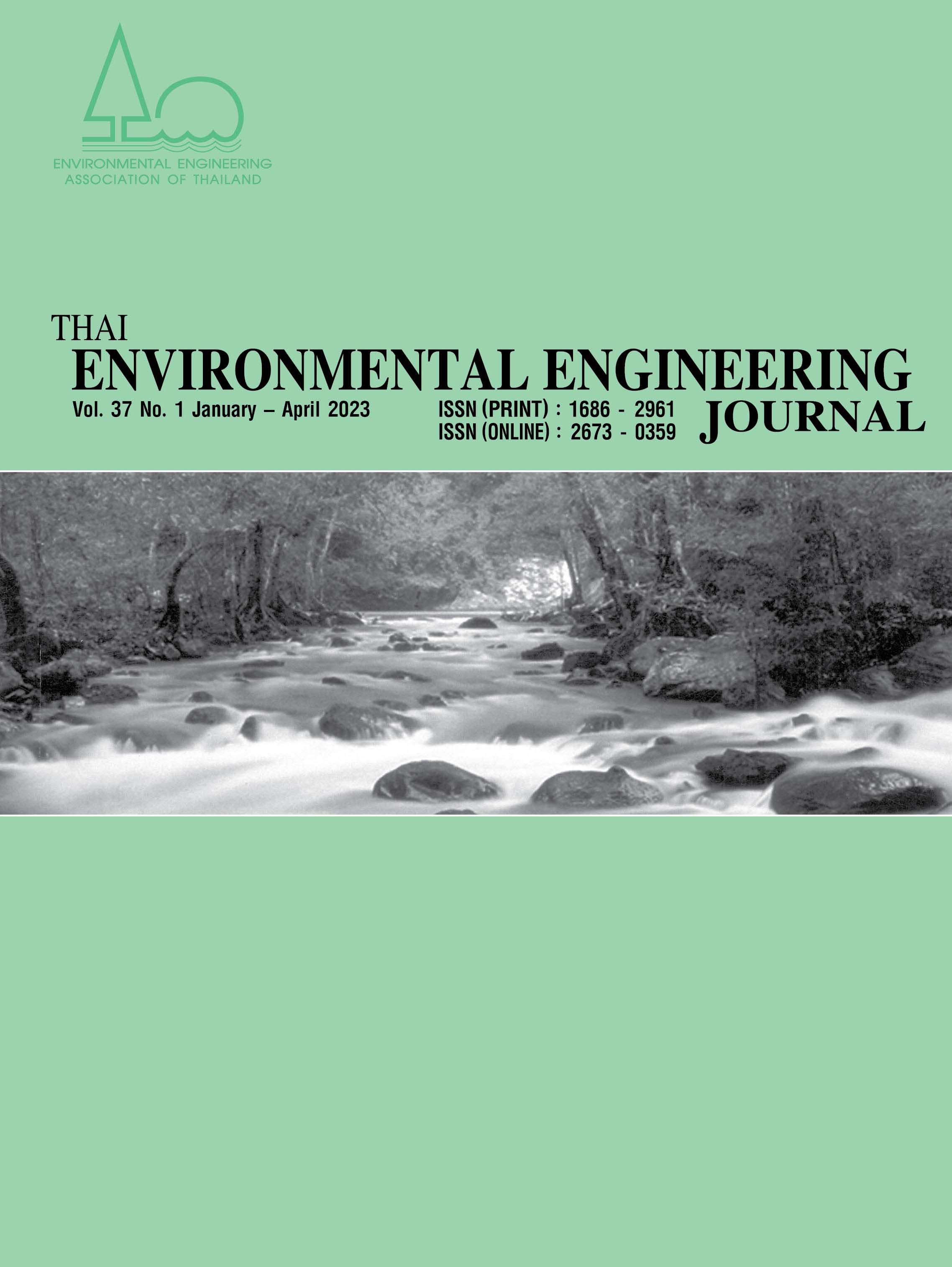Effect of Negative Aeration Rates on Water Balance in Biodrying of Wet-Refuse-Derived Fuel
Main Article Content
Abstract
Biodrying as a part of mechanic biological treatment (MBT) is a wide application method to reduce the excess moisture content in the substance and to improve the combustible materials as refuse-derived fuel (RDF) production process. The moisture content is reduced by evaporation and leachate generation during the biodrying process. To minimize the leachate generation due to it being more harmful to the environment, the optimization of the aeration rate should be assessed. Therefore, this study investigated the water balance under the variation of continuous negative aeration. The experiment set aeration rates of 0.4, 0.5, and 0.6 m3/kg/day. The operation time of each experiment was set to five days. This study was performed with a lysimeter scale using wet-RDF as a feedstock. The initial weight of wet RDF was 70.0 kg. At the end of the operation, the comparison of moisture content change in the feedstock and biodried products from evaporation and leachate generation was analyzed. The study illustrated that the highest moisture content reduction by evaporation was obtained from 0.4 m3/kg/day, followed by 0.5 m3/kg/day and 0.6 m3/kg/day, respectively. The highest water reduction by leachate generation was obtained at 0.6 m3/kg/day, followed by 0.4 m3/kg/day and 0.5 m3/kg/day, respectively. The final moisture content in the biodried product was 20.27 kg, 23.03 kg, and 23.47 kg from the negative aeration rates of 0.4, 0.5, and 0.6 m3/kg/day, respectively. Also, the moisture reduction of each experiment was 35%, 27%, and 26% that corresponding to weight reduction at 18%, 17%, and 15% of 0.4, 0.5, and 0.6 m3/kg/day, respectively.
Article Details
References
Hoornweg, D. and Bhada-Tata, P. 2012. What a Waste : A Global Review of Solid Waste Management. Urban development series; knowledge papers no. 15. © World Bank, Washington, DC. [online] accessible from:https://openknowledge.worldbank.org/entities/publication/1a464650-9d7a-58bb-b0ea-33ac4cd1f73c License: CC BY 3.0 IGO (10 October 2022).
PCD. 2020. Report on pollution situation in Thailand, the year 2020, in Ministry of Natural Resources and Environment, Ministry of Natural Resources and Environment: Thailand. [online] accessible from: https://www.pcd.go.th/pcd_news/12628 (1 October 2022).
Pharino, C. 2017. Challenges for sustainable solid waste management, lessons from Thailand. Springer. 15-28.
Tun, M.M. and Juchelková, D. 2019. Drying methods for municipal solid waste quality improvement in the developed and developing countries: A review. Environmental Engineering Research. 24(4): 529-542.
Nithikul, J., Karthikeyan, O.P. and Visvanathan, C. 2011. Reject management from a mechanical biological treatment plant in Bangkok, Thailand. Resources, conservation and recycling. 55(4): 417-422.
Bhatsada, A., Patumsawad, S., Itsarathorn, T. et al. (2023). Improvement of energy recovery potential of wet-refuse-derived fuel through bio-drying process. Journal of Material Cycles and Waste Management. 25: 637-649.
Yuan, J., Zhang, D., Li, Y., et. al. 2017. Effects of adding bulking agents on biostabilization and drying of municipal solid waste. Waste management. 62: 52-60.
Payomthip, P., Towprayoon, S., Chiemchaisri, C., Patumsawad, S. and Wangyao, K. 2022. Optimization of Aeration for Accelerating Municipal Solid Waste Biodrying. International Journal of Renewable Energy Development. 11(33): 878-888.
Zhou, H.B., Chen, T.B., Gao, D., et. al. 2014. Simulation of water removal process and optimization of aeration strategy in sewage sludge composting. Bioresource technology. 171:452-460.
Zhao, L., Gu, W.M., He, P.J. and Shao, L.M. 2010. Effect of air-flow rate and turning frequency on bio-drying of dewatered sludge. Water Research. 44(20): 6144-6152.
Haug, R.T. 1993. The practical handbook of compost engineering. Ann Arbor Science Publishers: New York, NY, USA. 261-286.
Huiliñir, C. and Villegas, M. 2015. Simultaneous effect of initial moisture content and airflow rate on biodrying of sewage sludge. Water research. 82: 118-128.
Yuan, J., Zhang, D, Li Y., et al. 2018. Effects of the aeration pattern, aeration rate, and turning frequency on municipal solid waste biodrying performance. Journal of environmental management. 218: 416-424.
Colomer-Mendoza, FJ., Herrera-Prats, L., Robles-Martinez, F., Gallardo-Izquierdo, A., Piña-Guzman, AB. 2013. Effect of airflow on biodrying of gardening wastes in reactors. Journal of Environmental Sciences. 25(5): 865-872.
Zhou, H., Shen, Y., Meng, H., Gao, D., Chen, T. 2018. Effect of air temperature and aeration strategy on water removal during sewage sludge composting. Drying Technology. 36(12): 1474-1480.
Wang, K., Li, W., Guo, J., Zou, J., Li, Y., Zhang, L. 2011. Spatial distribution of dynamics characteristic in the intermittent aeration static composting of sewage sludge. Bioresource Technology. 102(9): 5528-5532.
Sutthasil, N., Ishigaki, T., Ochiai, S., Yamada, M., Chiemchaisri, C. 2022. Carbon conversion during biodrying of municipal solid waste generated under tropical Asian conditions. Biomass Conversion and Biorefinery. 1-15.
Ngamket, K., Wangyao, K. and Towprayoon, S. 2021. Comparative biodrying performance of municipal solid waste in the reactor under greenhouse and non-greenhouse conditions. Journal of Environmental Treatment Techniques. 9(1): 211-217.
Bhatsada, A., Patumsawad, S., Towprayoon, S., et. al. 2023. Modification of the Aeration-Supplied Configuration in the Biodrying Process for Refuse-Derived Fuel (RDF) Production. Energies. 16(7): 3235.
Zhao, L., Gu, W., Shao, L., He, P. 2012. Sludge bio-drying process at low ambient temperature: effect of bulking agent particle size and controlled temperature. Drying Technology. 30(10): 1037-1044.
Ham, G.Y., Lee, D.H., Matsuto, T., Tojo, Y. and Park, J.R. 2020. Simultaneous effects of airflow and temperature increase on water removal in bio-drying. Journal of Material Cycles and Waste Management. 22: 1056-1066.
Yang, B., Hao, Z. and Jahng, D. 2017. Advances in biodrying technologies for converting organic wastes into solid fuel. Drying Technology. 35(16): 1950-1969.
Tom, A.P., Pawels, R. and Haridas, A. 2016. Biodrying process: A sustainable technology for treatment of municipal solid waste with high moisture content. Waste management. 49: 64-72.
Li, Q., Zhi, S., Yu, X., Li, Y., Guo, H., Yang, Z. and Zhang, S. 2019. Biodegradation of volatile solids and water mass balance of bio-drying sewage sludge after electro-dewatering pretreatment. Waste Management. 91: 9-19.
Cai, L., Chen, T.B., Gao, D., Zheng, G.D., Liu, H.T. and Pan, T.H. 2013. Influence of forced air volume on water evaporation during sewage sludge bio-drying. Water research. 47(13): 4767-4773.


